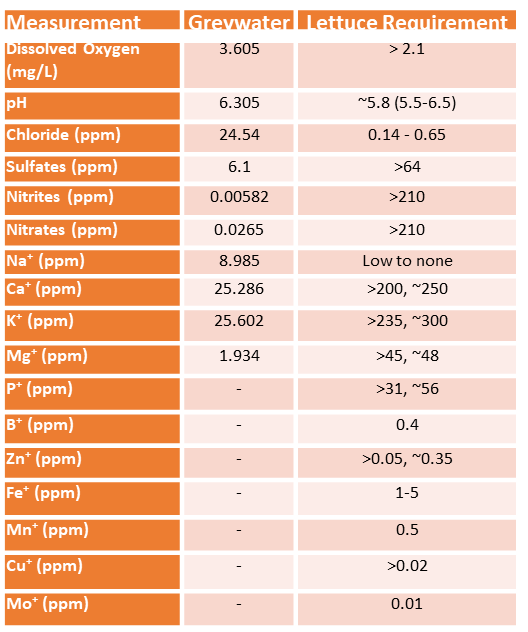Hydroponics
From Living Building Science
Contents
Overview
The Kendeda Building at Georgia Tech is one of the most sustainable buildings in the world because of its certification as a living building. Under the guidelines of the Living Building Challenge, there are 7 petals that buildings must fulfill: Beauty, Equity, Materials, Place, Water, Energy, and Health and Happiness. Of these 7, the Hydroponics team is primarily focused on Place, with an interest in Water. The Place petal focuses on urban agriculture; the process of growing food in a city environment. Given the unique qualities of a hydroponic system - soilless and water efficient - it is an excellent way to fulfill the Place petal.
Previous Design of Hydroponics System
Hydroponic systems are classified as two types: open and closed. For the scope of this project, a closed wick system, which is both convenient and cost-effective, will be used. A simple wick system consists of a tank with a tray of pots resting on the lid. The tank is filled with a nutrient solution that contains the essential macro and micro nutrients that plants need to survive. Holes are cut into the tank lid so synthetic wicks can run from the pots to the nutrient solution below. The pots are filled with a soilless growing medium; typically coconut fiber or vermiculite, a type of mineral. Additionally, an air pump and air stone are used to oxygenate the nutrient solution so the plants do not suffocate. Plants receive nutrients via capillary action as the nutrient solution travels up the wick.
Current Systems
Current systems as of Spring 2022 were chosen to be three, AeroGarden Harvest Slim systems, including an LED grow-light with 6 planting pods each. This design system is similar to previous closed wick systems that were initially planned, however due to convenience and time restraints, pre-made systems resulted in less variability, construction associated costs, and time management required by the experimental design.
Research
Project Goal
Will the addition of synthetic urine to hydroponics systems impact the growth of Genovese basil? Amending nutrient requirements with synthetic urine is a common practice in traditional agriculture and has yet to be tested within hydroponics use. Experimenters used BioSpira nitrifying bacteria to convert synthetic urine solutions into effective fertilizers, which are currently utilized within nutrient solutions of varying concentrations in order to monitor plant growth and health, measured through chlorophyll spectrophotometry and basic quantitative analysis.
Methodology
Experimenters conducted procedure with three, six-pod, AeroGarden hydroponics systems growing Genovese basil in three nutrient solutions with varying synthetic urine concentrations.Additional nutrient supplements were added through included AeroGarden fertilizer every 2 weeks. Comparisons were made with chlorophyll spectrophotometry coupled with physical evaluations of plant growth and health. Later experimental designs will be altered to include water quality testing to monitor nutrient levels within the system throughout plant maturation.
Charts and Figures
 Greywater data taken from: Greywater Wetland
Greywater data taken from: Greywater Wetland
Final Posters
Annotated Bibliography
1. Zhou, J., Li, P., Wang, J., & Fu, W. (2019). Growth, Photosynthesis, and Nutrient Uptake at Different Light Intensities and Temperatures in Lettuce, HortScience horts, 54(11), 1925-1933. Retrieved Dec 6, 2021, from https://journals.ashs.org/hortsci/view/journals/hortsci/54/11/article-p1925.xml
- For medium temperatures (23 °C/18 °C), light intensities of 350 to 600 μmol·m−2·s−1 are recommended, and 500 μmol·m−2·s−1 is the optimal value during the middle of spring and autumn.
2. Schumann, T., Paul, S., Melzer, M., Dörmann, P., & Jahns, P. (2017). Plant Growth under Natural Light Conditions Provides Highly Flexible Short-Term Acclimation Properties toward High Light Stress. Frontiers in plant science, 8, 681. https://doi.org/10.3389/fpls.2017.00681
- Tested properties of plants under different light conditions, found that naturally fluctuating light produced plants that were more able to acclimate to different light conditions.
3. Shirly Tentile Magwaza, Lembe Samukelo Magwaza, Alfred Oduor Odindo, Asanda Mditshwa, Hydroponic technology as decentralised system for domestic wastewater treatment and vegetable production in urban agriculture: A review, Science of The Total Environment, Volume 698, 2020, 134154, ISSN 0048-9697, https://doi.org/10.1016/j.scitotenv.2019.134154. (https://www.sciencedirect.com/science/article/pii/S0048969719341312)
- Use of a hydroponics system as a tool for wastewater treatment: indicates that using wastewater/greywater for hydroponically growing crops is cost-effective and potentially more beneficial.
Team Members
| Name | Major | Years Active |
|---|---|---|
| Pallavi Natarajan | Chemical Engineering | Fall 2021 - Present |
| Cecil Hash | Biology | Fall 2021 - Present |
| Zohir Khawaja | Civil Engineering | Fall 2021 |
| Aidan Blackshire | Environmental Engineering | Spring 2022 |


